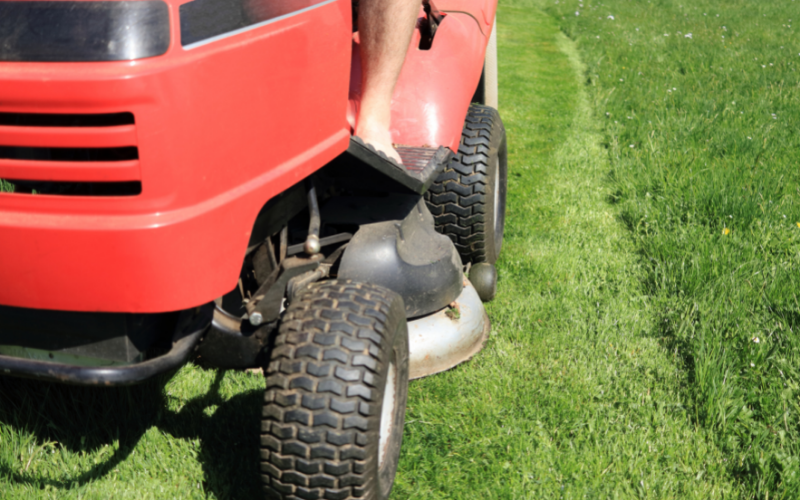You hear friends talk about how they’ve been using the same lawn mower belt for 5 seasons straight. You’ve been through 2 this season alone. It’s enough to make you want to scream as 2 just became 3…”Why does my lawn mower belt keep breaking?!”
I’m going to run through a list of factors that will typically contribute to the accelerated wear and more frequent breaking of lawn mower belts in this post. It’s then up to you to get to the root of the problem to help increase the lifespan of your belts and save yourself a few bucks in the process!

Why Does My Lawn Mower Belt Keep Breaking?
If your lawn mower belt keeps breaking it could be due to a number of factors including the quality of the belt itself, damaged pulley bearings, rust or sharp edges on pulley grooves, debris building up inside pulley grooves or a weak tensioner spring.
Reasons Lawn Mower Belts Keep Breaking
Replacing the belt on your lawn mower is not the most expensive repair job, but if you’re doing it several times per season, it can really start to add up.
Below I’m going to cover a few different factors that can lead to accelerated belt wear and their relatively rapid demise. Check out each of these factors on your own mower to see if one of them could be to blame.
Poor Quality Belts
Not all lawn mower belts are made equal. It’d be easier if they were, but they’re not. If when the original belt broke (if you’ve owned your mower from new) you replaced it with a cheap aftermarket belt, that could be your issue right there.
They’re cheap for a reason. They just don’t stand up to the wear and tear as well and can end up breaking very quickly.
Always go with an OEM belt. I’ve also heard extremely positive feedback from folks that have bought Kevlar belts too.
One friend who was previously going through belts like they were going out of fashion, switched over to Kevlar and now gets several seasons out of each belt.
Damaged Pulley Bearings
You’ll need to remove your belt to check this. Once you have it off, what you need to do is check that all of the pulleys still spin freely. If you find one or more that don’t, this could be the root of the problem.
These pulleys will cause significantly more friction when the blades are engaged, which will increase wear on the belt. If you do notice this, it’s likely the bearing that is damaged and will need to be replaced.
Rust or Sharp Edges on Pulleys
If you completed the last check and all of the pulleys seem to spin freely, as they should, pass your hand over the groove in each of the pulleys, where the belt sits when in operation. This surface should be smooth. What you’re looking for here is rust or any signs of a sharp edge.
If you do find any evidence of this, it needs to be resolved immediately, as when a belt is passing over this at high speeds it’s going to cause damage.
You may be able to sand this down and seal it. If not, the pulley will need to be replaced.
Debris in Pulley Grooves
How many times do you really clean your deck…After every session? Or when you feel like it? For most people it’s the latter and that can lead to problems when it comes to your lawn mower belt. Two different problems to be exact.
If grass clippings get into the pulley grooves and over time build up, this can end up causing your belt to stretch. Even if it only stretches very slightly, this could lead to it becoming too loose. Loose belt = your lawn mower belt keeps coming off, and that’s no fun! Alternatively, it might just cause it to slip frequently, and this causes greater wear on the belt.
There’s another type of debris that you need to watch out for, especially if you have a sandy lawn. If sand, small bits of rock, and sticks make their way into the pulley grooves, they could cause a great deal of wear to the mower belt and result in it breaking well ahead of time.
So take the belt off and have a thorough inspection inside the grooves to make sure they’re smooth, clean and debris-free.
Weak Tensioner Spring
This is another good part to check. Springs wear out over time and if the tensioner spring on your unit has become weak, it could be causing the belt to slip. It’ll still allow it to operate, but this slippage causes extra friction and will result in your belt breaking quicker. The solution is simple: swop the spring out for a new one.
Final Thoughts
It’s easy to just keep replacing your belts each time they break, hoping the next one will last longer. But crossing your fingers and hoping for the best rarely brings you the outcome you want. Instead, you need to ask yourself why does my lawn mower belt keep breaking, and then try to find the answer by taking a close look at your lawn mower. There’s almost always a logical explanation; you just need to find it.


Hi Tom, I have a 2019 SCAG Tiger Cat II. I cut 27 lawns per week, mostly .8 acre each. My long belt broke for the first time last week. I figured it was just wear. I replaced the belt. After 6 lawns the brand new OEM belt broke. After reading your article, I realized that the rear-most pulley was not spinning. I assumed it was a fixed pulley. I must be wrong about this? Taking my machine to the SCAG dealer where I bought it in the morning. Can’t wait for them to tell me I’ll have to leave my machine with them, which is my only machine, and I have lawns to do.
Hey Brian!
Sorry to hear you’re having belt problems. That’s the worst, I sure hope the SCAG dealer gave you better news than you were expecting. Also, I think you were right to assume that the rear pulley is causing problems. I can’t say with certainty but I’ve never heard of a belt pulley that doesn’t spin.
Since you used an OEM belt I wouldn’t attribute its failure to a bad part. When it comes to a pulley that doesn’t spin I believe there are a few things that could be causing it. You might be looking at bad bearings, spindle trouble, or just a damaged pulley itself. I would try taking apart the pulley assembly if you can and checking that out first.
Let us know how you get on.
Tom.
I have a TroyBilt pony after the factory belt broke I can’t keep a belt on it. It’ll maybe stay on 30 minutes at best. I’ve bought new deck new pulleys, a new tensioner spring and it’s still breaking. Any thoughts? Thanks
Hi James,
If you take a look in your owner manual, you should find a specific belt deflection number. This is a number that you can use to check the tension of your belt. Now you will need a tension gauge to test the deflection of the belt, but this is the only accurate way to test a belt. I would say that there is an issue with the tension, and this is the reason your belt is falling off.
Unfortunately, I don’t believe you can adjust the belt tension on a pony, so you won’t be able to make an adjustment. But it will tell you if you have too much or too little tension. If it’s too loose, then either the belt or the tension spring is stretched, or if it’s too tight, then you’ll likely need a different spring, or you could have the wrong belt.
You should be able to find an inexpensive belt tension gauge online.
I hope this helps.
Tom.